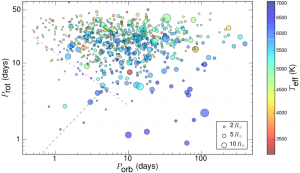
Figure 2 from McQuillan+ (2013) showing rotation periods of host stars (P_rot) vs. orbital periods of planetary candidates (P_orb). The size of the circle indicates the size of the planetary candidate, and the colors indicate stellar temperature.
In journal club today, we first discussed the recent tenth release of data from the third Sloan Digital Sky Survey (SDSS III). The survey basically takes a mammoth picture of the sky every night and provides a wealth of astronomical data that can be used to map the Milky Way, search for extrasolar planets, and solve the mystery of dark energy. According to the wikipedia, SDSS collects about 200 GB of data every night, so, over the last year, the survey has collected tens of terabytes of data.
We also talked about a recent paper by McQuillan, Mazeh, and Aigrain. These authors analyze the brightness variations of many stars observed by the Kepler mission that are orbited by planetary candidates.
Like the Sun, many stars have star spots, cooler and darker regions on their faces, and these spots rotate in and out of view as the stars rotate, just like those on the Sun. When the spots rotate into view, the star appears to darken slightly, and so you can use brightness variations to determine the star’s rotation rate. (Watching the motion of sun spots is how the Sun’s rotation rate was first determined.)
The authors suggest a correlation between the rotation periods of these host stars and the orbital periods of their planetary candidate companions: there is a dearth of planetary candidates with short orbital periods around stars with short rotation periods.
Our journal club group raised several questions about these results. Among them, we wondered whether there are any biases in the sample of studied stars that could account for the correlation. Also, could it be harder to find planetary candidates around faster rotating stars (faster rotating stars could exhibit brightness variations rapid enough that they confuse the Kepler transit search for planets) — could this idea account for the correlation?
However, if no underlying biases or sampling issues account for the correlation, then the results say something interesting about the connection between planets and stars. Why do planets close to their stars (i.e., with short periods) seem to prefer orbiting stars that rotate slowly?